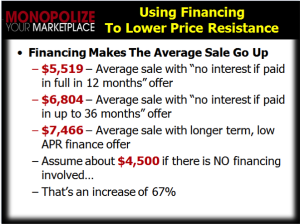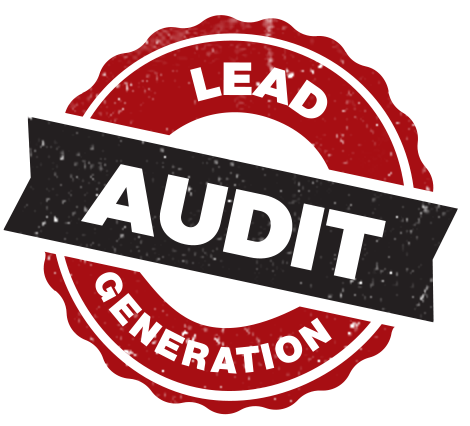Dozens of Money-Making Opportunities Are Sitting Right Under Your Nose. Learn How Find & Exploit Them.
By Rich Harshaw
When it comes to home improvement lead generation and generating new business for remodeling companies, the discussion almost always focuses on advertising, internet marketing, home shows, or all three.
And for good reason: these are the obvious places to find new customers that have reliably generated business for years.
But I’ve found that there are some FAR LESS OBVIOUS places to look for business that can be extremely profitable if you just know where to look. Most companies never realize that these opportunities even exist, or if they do, they don’t realize they are as fat and juicy as they actually are.
That’s why I call these “hidden assets.”
These are assets your company possesses that you might not even recognize. The purpose of this post is to identify what some of them are… and show you how to exploit them to your advantage.
Disclaimer: Not every hidden asset will apply to every company. And you may already be taking advantage of some of them. So read through this list with an open mind… and take notes as you go. I think you’ll find this to be a worthwhile endeavor.
Hidden Asset #1 – Past Customers: Yes, I know this is pretty obvious. And some of you reading this probably already do a pretty good job of getting more sales out of past customers. But in my experience, this is the #1 most fertile place to drum up sales, and it’s almost NEVER approached in a systematic way. Instead, most repeat business comes from old customers who happen to need something, happen to remember doing business with you before, and happen to call. There’s nothing “wrong” with that except it could be much better.
Getting Them To Buy Again: The first thing you should be doing is reselling your past customers. The easiest way to do this is to gather an email and mailing list for them and send them monthly emails and quarterly snail-mailers to remind them that you exist, and to poke them into thinking about other needs they might have. Yes, it costs time and money to do this, but so do all marketing activities. If you’re not doing EXACTLY what this paragraph says, I promise you that you’re making less money than you should.
Click on this post and scroll to “Idea #2” for a couple of cools ways to accomplish this. The check mailer idea can make you a quick windfall—if you do it!
Also consider selling a DIFFERENT product if you don’t right now—don’t get crazy with this… but if you sold a roof, you could probably sell and install siding or windows. If you’re not sure, send out a letter offering it to a few hundred of your customers and gauge the response. If it’s good, figure out how to sell and fulfill it.
Referrals: Same thing—you should be emailing monthly and mailing quarterly if you want to get referrals. Remember that the majority of referral opportunities are going to occur AFTER you sold the job, the customer is happy, and the subject of (roofs, windows, kitchens, etc.) comes up in natural conversation with their friends. You have to keep in front of their faces OFTEN so they remember who you are so they can refer you over to those friends. Simple, yet almost ALWAYS neglected.
Surveys: I’m not necessarily talking about formal surveys that are emailed over to them (although those are good, too); I’m talking about talking to your customers specifically about what you do, how you can improve, what they like and don’t like, what their decision-making process was when choosing you, what other services they might buy from you (and when!), and so forth. Don’t be afraid to send somebody over there after the fact and just TALK to them. Pump them for information. Ask for honest feedback. Find out how you can improve—they know!!!
Hidden Asset #2 – Financing: For most remodelers, offering financing UP FRONT, as part of the standard sales process is the absolute EASIEST way to increase your average sale amount. Consider this information from an industry financing source in this slide.
this information from an industry financing source in this slide.
Here’s what that means: When people are given a chance to pay it out over time, they SPEND MORE. PERIOD. End of conversation. You can’t debate this with me because it’s a documented fact.
Yet most remodelers only pull financing out of their bag of tricks as a last ditch effort to close sales if they encounter price resistance. I say ELIMINATE the price resistance before you ever start the conversation with the prospect by talking in terms of monthly payments, not total project cost. Asking them “How much were you thinking would fit into your monthly budget?” when FIRST sitting down is an easy way to get their mind off the fact that the project is $12,000. If you don’t, the customer will cut the scope of the project and give you less money.
And the money you pay to the financing company is chickenfeed compared to the increased sale. From the slide above, if it cost you 6% to increase the sale from $4,500 to $7,466, that’s almost $450 in increased cost. But if your margin is 50%, then you have an extra $1,500 in margin, for a NET NET NET EXTRA PROFIT of about $1,000 on the job. This is a no brainer. Seriously.
Hidden Asset #3 – Competitors – Lead Sharing: This is a sneaky list! Even your competitors can be a money-making asset to you. How? Think about how much money you pay to generate a good home improvement lead–$200… $400… $500? Now, let’s say we have 2 window companies: one that sells windows for $650, and another that sells windows for $1,200. The more expensive company could sell it’s UNSOLD home improvement leads (ie, ones that don’t convert) to the lower price window company for either a set price per lead, or for a percentage of the sale.
This works for both parties: one company makes CASH money for the leads it sells, the other company gets leads for a reduced rate (or a participation, if possible).
What if you were the lower priced window company in this example? How many higher-priced window companies could you approach and “partner up” with? As many as your imagination and salesmanship skills would allow you to.
Hidden Asset #3.5 – Competitors – Cost Sharing: What if you found four or five companies that sold the same thing as you at about the same price as you…windows, roofing, bathroom remodeling, whatever… and you got together, pooled your money, and ran a BIGTIME advertising campaign? If you live in a big market, this could make a lot of sense. Each of you pool $5,000 a month, and now you suddenly have $25,000 for an awesome radio campaign. Naturally, you’d only want to associate this way with companies you trusted, and you’d have to find a way to split the leads up in an equitable way (geographically, every 5th lead, etc.), and you would probably want to form a formal alliance of some sort… BUT WHY NOT TRY THIS????? This is about thinking outside the box. Quit hating your competitors and start working with (some of) them to your mutual benefit!
Hidden Asset #4 – Current Customers – Upselling & Cross-Selling: I’ll keep this one short: you can make more money by selling more stuff to your customers at the point of sale. Obvious as it seems, very few companies put any effort into selling anything other than what the customer already expected to by going into the sales meeting.
There are many ways to sell extra, but let’s focus on just one: Packaging. Let’s say that you sell windows at $650 each, and your average sale is ten windows for a total average ticket of $6,500. Now package in several things that if purchased extra would cost a lot more money:
- Glass Breakage Warranty: $50 each x 10 windows = $500
- Lifetime Warranty Upgrade: $50 each x 10 windows = $500
- Krypton Gas Upgrade: $75 each x 10 windows = $750
- Installation Upgrade (full replacement): $75 each x 10 windows = $750
- Total for all extras: $2,500
Now you tell customers that if they buy ten or more windows from you, they can get all four upgrades for only $35 per window…. $350 dollars. That $350 is 100% pure profit (minus any sales commissions on it).
You may say, “We already include those things” or “those things don’t apply to my business.” And you’re missing the point. Don’t poo-poo an idea just because the specifics of the example don’t suit your situation. Find something that you can package to increase the sales price and take home more profits.
Hidden Asset #5 – Past Prospects Who Didn’t Buy: Industry statistics say that 70% of prospects who don’t buy are going to end up buying from SOMEONE within twelve months. Yet most remodeling companies never attempt to proactively reach back out to unclosed leads and sell them again. They just assume that if their big, bad closers couldn’t get the job done, then the prospect must be “broke and/or stupid.”
The reality is different: the #1 reason prospects don’t buy right away is STICKER SHOCK! The amount they were expecting it to cost is less than you asked them for. In many cases, they CAN afford your price, and they WANT to do business with you. They just need time to come to grips with the price, or in some cases, save up the money (note: see above about financing). Your job, then, is to keep yourself in front of them and get them when they’re ready.
This is easily accomplished with a series of emails and postcards. But here’s the surprising part: you can actually afford to send WAY MORE mail than you think. Here’s why: assume your average home improvement lead cost is $250, and your closing ratio is 33%. That means that for every 100 leads you get, you’re spending $750 in marketing cost to get that deal ($250 lead cost x 3 prospects required to get a sale = $750 customer acquisition cost). That also means that you have sixty-seven unclosed leads for every 100 prospect you pursue. If you figure you could close just 10% of those, that’s 6.7 extra sales (round it up to seven)… which means you could allocate $5,250 to the follow up marketing to those sixty-seven people. That’s $78 each. If postcards cost $0.60 each, that’s 130 postcards… or one postcard per week for 2 ½ years. Read this paragraph again and think about this. No, really—do it.
Hidden Asset #6 – Longevity In Business: I was talking to my mortgage guy, Rodney Anderson, last time I bought a house about eleven years ago. It was the third time I’d used him out of three houses bought, and as usual, I started quizzing him about his marketing. He had recently switched from a local phone number on his radio ads to a toll-free “vanity” number, and I wanted to know if he’d seen an uptick in response rates. He told me it was too soon to tell; check back with him later.
Then I asked him what his best marketing tool was—what single thing brought him the most business. His immediate response: “Being in business for over twenty years.” He explained that due to the repetitive nature of home buying, that I was the epitome of his typical customer with three homes bought (mortgages) in nine years. He said that new people were coming into the mortgage business all the time (it was 2004) and they left almost as fast as they showed up. He then boldly proclaimed that he could shut off ALL of his advertising for a FULL YEAR and still be the #1 volume (transactions and dollars) mortgage broker in Texas. Why? Because he already has twenty years’ worth of people who automatically call him when they need a mortgage.
If you’ve been in business a long time, your phone is going to ring no matter what, just like Rodney’s. But unfortunately, it could also be hurting you because your “automatic” sales are probably bringing down the average marketing cost you spend to find new customers. That probably means that your marketing cost as percentage of sales is actually LOWER than it should be. When other remodelers talk about spending 10% or 14% of 17% of sales on marketing, you laugh inside (or out loud!) knowing that you only spend 2% or 3% or 5%.
Instead, you should use your longevity as a hidden asset. Instead of spending 3% on marketing, spend 10% on marketing. This will give you a HUGE, MASSIVE, GIGANTIC competitive advantage on everyone else, and will likely be the spark that takes you from $2 million in sales (again) to $10 million in sales (if that’s where you aspire to be). Let’s run the math:
- Relatively new competitor doing $2 million in sales spends
- Spends 12% on marketing = $240,000
- Almost all of the $2 million in sales comes from this advertising budget
- Next year they will probably spend about the same and sell about the same
- They’ll probably grow slowly over the next ten years
- You in business for 20+ years doing $2 million in sales
- You currently spend 3% on marketing = $60,000
- The $60,000 in spend accounts for $600,000 of your $2 million in sales
- $1.4 million is coming from your longevity
- Up your spending to 12% = $240,000 (same as competitor, above)
- Your $240,000 spend brings in $2 million in sales
- Add this to your existing $1.4 million from old customers
- You are now doing $3.4 million—your company just got a lot bigger really fast
- You now have a budget of $408,000 for the next year
- Off you go!
I’ve seen this scenario 1,000 times—old-school companies living off “repeat and referral” that are hindering their own growth because of reluctance to spend on marketing. Break the chains and leverage your hidden asset into big dollars!
That’s all for this time… next blog posting we’ll cover six additional hidden assets, including relationships, expertise, easy discounts, suppliers, identity, speed, and employees.
************
Marketing Audit: Want to know if your marketing will work? We’ll perform a marketing plan analysis and give you a number grade from 0 to 100 so you’ll know for sure. Just fill out this form and we’ll contact you to schedule a time to discuss. Important! Please DO NOT fill this form out if you do not intend to actually meet with us to discuss. We have to invest a substantial amount of time and work into preparing these reports. Thanks!
[Formstack id=1656493 viewkey=CxJVwBWHSF]
© 2015 – 2016, Rich Harshaw. All rights reserved.








